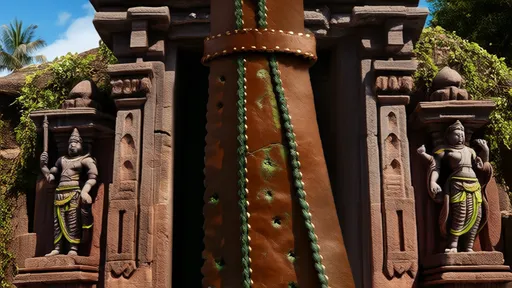The ancient temples of India stand as magnificent testaments to the country's rich cultural and spiritual heritage. Among the many intriguing aspects of these sacred structures, the presence of belts or girdles—often overlooked—holds deep symbolic and functional significance. These belts, carved into the stone of deities or worn by temple dancers, are not mere decorative elements but carry layers of meaning tied to tradition, mythology, and even social hierarchy.
In the intricate carvings of temples like Khajuraho, Konark, and Meenakshi, belts adorn the waists of celestial beings, gods, and goddesses. These girdles, often embellished with intricate patterns and motifs, serve as markers of divinity and power. For instance, the belt worn by Lord Shiva in his Nataraja form symbolizes the cosmic dance of creation and destruction. The meticulous craftsmanship reflects the artisan's devotion, transforming a simple accessory into a sacred emblem.
Beyond their spiritual connotations, belts in Indian temples also played a practical role in the lives of temple dancers, or devadasis. These women, dedicated to serving the deities through dance and music, wore ornate belts as part of their traditional attire. The jingling of bells attached to their girdles accompanied their rhythmic movements, creating an auditory and visual spectacle during rituals. Over time, however, the devadasi system became controversial, and the belts once symbolizing devotion were entangled in debates about tradition and exploitation.
The materials used in these temple belts varied widely, from gold and silver for deities to simpler metals and fabrics for human wearers. In some temples, belts were even inscribed with prayers or mantras, believed to amplify their spiritual potency. The choice of material often reflected the wearer's status—precious metals for gods and goddesses, humbler materials for devotees. This distinction underscored the hierarchical nature of temple culture, where even accessories served as markers of identity.
Today, the belts of Indian temples continue to fascinate historians and art enthusiasts alike. They are studied not only for their aesthetic appeal but also for the stories they tell about India's past. Whether as symbols of divine authority or relics of a bygone era, these girdles remain an enduring link between the material and the spiritual, the human and the divine.
In modern times, the legacy of temple belts lives on in contemporary fashion and jewelry design. Designers often draw inspiration from these ancient motifs, reinterpreting them for a global audience. Yet, the original belts, frozen in stone or preserved in temple treasuries, retain an aura of mystery and reverence. They remind us that even the smallest details of India's temple architecture are imbued with profound meaning, waiting to be uncovered by those who look closely enough.

By /Aug 13, 2025

By /Aug 13, 2025

By /Aug 13, 2025

By /Aug 13, 2025

By /Aug 13, 2025

By /Aug 13, 2025

By /Aug 13, 2025

By /Aug 13, 2025

By /Aug 13, 2025

By /Aug 13, 2025

By /Aug 13, 2025

By /Aug 13, 2025

By /Aug 13, 2025

By /Aug 13, 2025

By /Aug 13, 2025

By /Aug 13, 2025

By /Aug 13, 2025

By /Aug 13, 2025

By /Aug 13, 2025

By /Aug 13, 2025